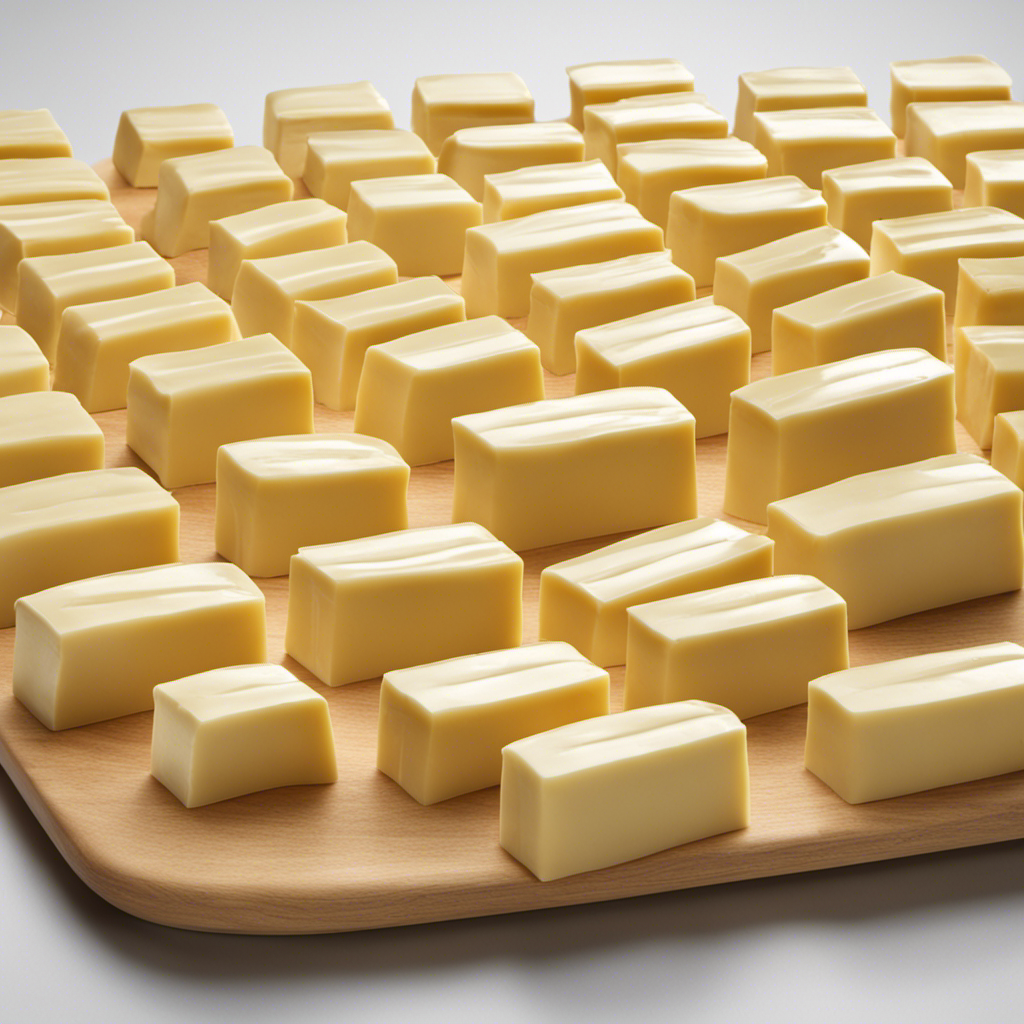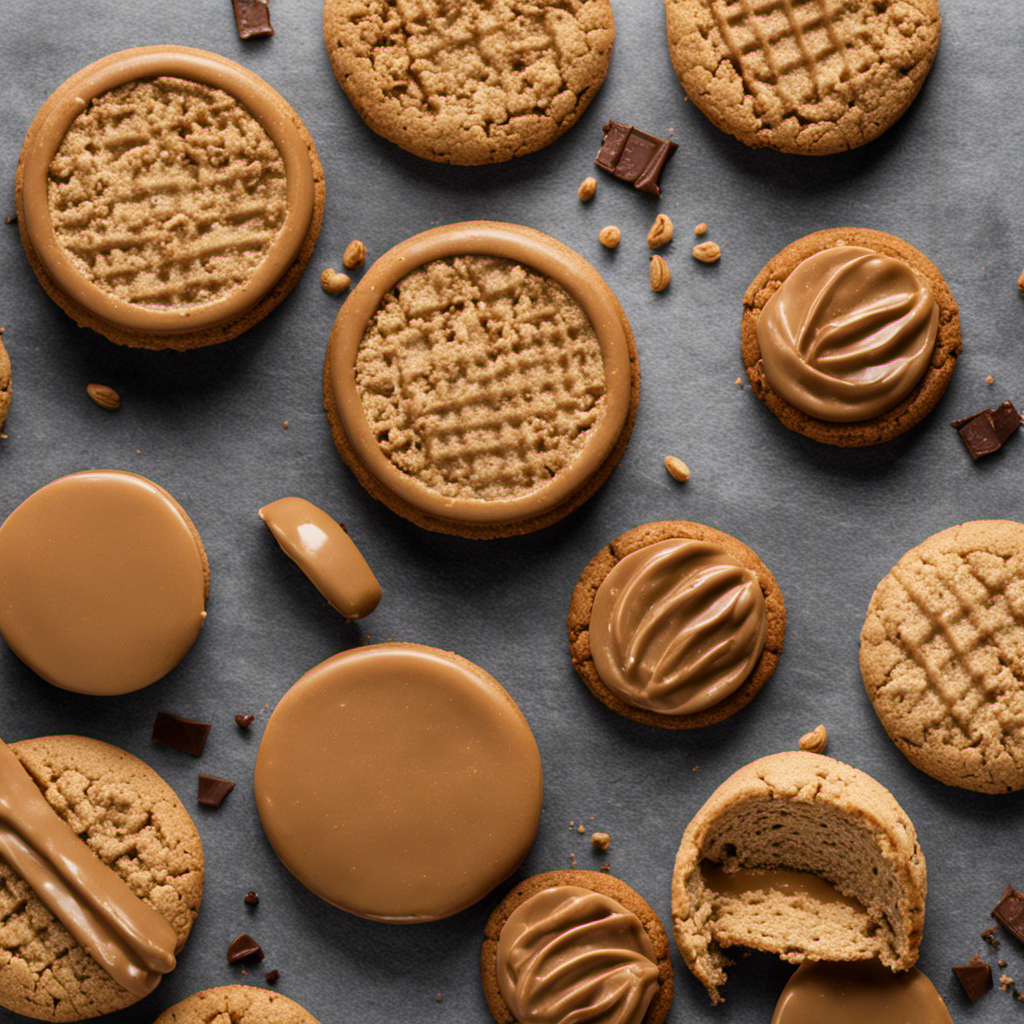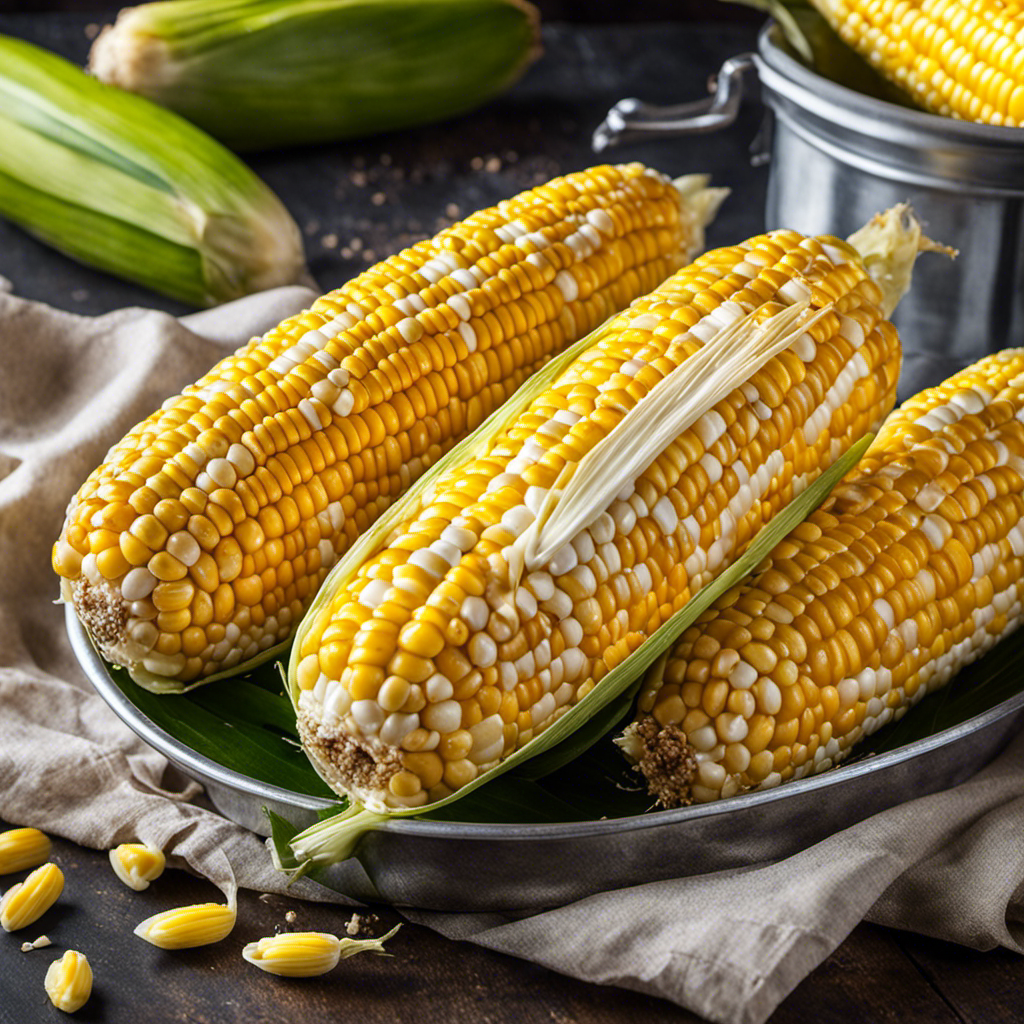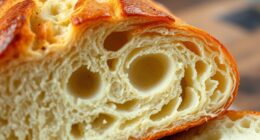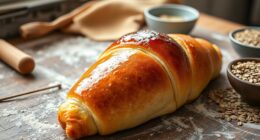Picture the joy of spreading freshly made butter on a slice of freshly baked bread.
In this article, I’ll share my simple and foolproof method for making butter from buttermilk. We’ll gather the materials, choose the perfect buttermilk, separate the cream, chill it, and then whip it into delicious butter.
I’ll guide you through each step, from draining the buttermilk to washing the butter. Get ready to create the creamiest, tastiest butter you’ve ever had.
Let’s get started!
Key Takeaways
- Choose the right buttermilk based on personal preference and recipe requirements, considering factors such as fat content and flavor.
- Use proper cream separation methods, such as gravity, centrifugation, skimming, sieving, or churning, to obtain fresh buttermilk for flavorful butter.
- Whip the cream using chilled equipment and gradually increase mixer speed to achieve a light and fluffy texture, checking for soft peaks to form and hold their shape.
- Shape the butter using techniques such as rolling it into a log shape or using butter molds, and consider adding salt for enhanced flavor, extended shelf life, and a savory element, based on personal taste preferences.
Gathering the Materials
Before starting, make sure you’ve gathered all of the necessary materials.
When making butter from buttermilk, it is important to choose the right container and maintain temperature control during cream separation.
For the container, I recommend using a glass jar with a tight-fitting lid. Glass is non-reactive and won’t affect the flavor or quality of the butter. It’s also important to ensure the jar is clean and sterilized to prevent any unwanted bacteria from contaminating the buttermilk.
When it comes to temperature control, it’s best to keep the cream at around 55°F to 60°F. This allows for proper separation of the butterfat from the buttermilk.
Once you have gathered all the necessary materials and set the right temperature, you can proceed to the next step of choosing the right buttermilk.
Choosing the Right Buttermilk
When choosing the right buttermilk, it’s important to consider the fat content in order to achieve the desired consistency. There are several options available, including fresh buttermilk, which is the traditional choice, and alternative options such as low-fat or non-fat buttermilk.
Fresh buttermilk is made by churning cream into butter and then adding a culture to ferment it. It has a rich, creamy texture and a tangy flavor. However, if you prefer a lighter consistency, you can opt for low-fat or non-fat buttermilk, which have a lower fat content and a milder flavor.
Ultimately, the choice depends on personal preference and the specific recipe you are using. Now that you know how to choose the right buttermilk, let’s move on to the next step: separating the cream from the buttermilk.
Separating the Cream From the Buttermilk
When it comes to separating cream from buttermilk, there are a few techniques that I have found to be effective.
One method involves allowing the mixture to sit undisturbed in the refrigerator overnight, allowing the cream to rise to the top.
Another technique involves using a specialized cream separator, which helps to separate the cream from the buttermilk more efficiently.
It is important to note that using fresh buttermilk is crucial for achieving a delicious and flavorful butter, as it adds a tangy taste to the final product.
As for the equipment needed, a butter churn or a stand mixer with a whisk attachment can be used to agitate the cream and turn it into butter.
Cream Separation Techniques
To separate the cream from the buttermilk, you’ll need to let the mixture sit undisturbed for a few hours. During this time, the cream will rise to the top, while the buttermilk settles at the bottom.
Here are some cream separation methods that I’ve found effective:
- Gravity: Allowing the mixture to naturally separate by leaving it undisturbed.
- Centrifugation: Using a machine to spin the mixture at high speeds, causing the cream to separate.
- Skimming: Carefully scooping off the cream from the top of the mixture.
- Sieving: Pouring the mixture through a fine mesh sieve to separate the cream from the buttermilk.
- Churning: Agitating the mixture vigorously to encourage the separation of cream and buttermilk.
Now that we’ve successfully separated the cream, let’s move on to the importance of fresh buttermilk in the process of making butter.
Importance of Fresh Buttermilk
Fresh buttermilk is essential for achieving the desired texture and flavor in your homemade recipes. Not only does it add a tangy and creamy taste to dishes like pancakes, biscuits, and dressings, but it also provides several health benefits. Buttermilk is low in fat and calories, making it a healthier alternative to whole milk. It is also rich in calcium, which is important for strong bones and teeth. Additionally, buttermilk contains probiotics, which promote a healthy gut by improving digestion and boosting the immune system.
Here is a table highlighting the nutritional content of fresh buttermilk:
| Nutrient | Amount per 1 cup |
|---|---|
| Calories | 99 |
| Fat | 2.2g |
| Carbohydrate | 17g |
| Protein | 3.3g |
| Calcium | 285mg |
Incorporating fresh buttermilk into your recipes not only enhances the taste but also provides you with these essential health benefits. So, don’t hesitate to include it in your next culinary adventure.
Butter-Making Equipment Needed
You’ll need a few essential pieces of equipment to successfully create homemade butter. Here are the key items you’ll need:
-
Butter churn: This is the main tool used to agitate cream and separate the butterfat from the buttermilk. It can be a traditional hand-crank churn or an electric churn for convenience.
-
Cream separator: If you’re starting with fresh milk, a cream separator will help you extract the cream from the milk before churning.
-
Butter muslin or cheesecloth: These are used to strain the buttermilk from the butter during the churning process.
-
Butter paddles or butter molds: These tools are used to shape and work the butter, removing any excess moisture and creating a smooth texture.
-
Salt: Optional, but adding a pinch of salt can enhance the flavor of your homemade butter.
With these equipment items, you’ll be well-equipped to embark on your homemade butter-making adventure.
Chilling the Cream
First, make sure you refrigerate the cream for at least 12 hours to chill it properly. Chilling the cream is crucial for successful butter making. The cream temperature should be around 45-50°F (7-10°C) to achieve the best results.
When the cream is refrigerated for a sufficient amount of time, it becomes cold and thick, which helps in separating the butterfat from the buttermilk later on. This process of chilling also helps to stabilize the cream and prevents it from splattering during the whipping process.
Once the cream has been chilled, it is ready to be whipped into butter. So, let’s move on to the next step and learn how to whip the cream to turn it into delicious homemade butter.
Whipping the Cream
When it comes to whipping cream, there are a few crucial tips to keep in mind.
First, make sure to use a chilled bowl and beaters for the best results.
Secondly, gradually increase the speed of the mixer to achieve a light and fluffy texture.
Lastly, check the cream’s consistency by lifting the beaters – if soft peaks form and hold their shape, it’s ready.
The time required for whipping can vary depending on the cream’s fat content and the desired level of stiffness, but on average, it takes about 3-5 minutes.
Whipping Technique Tips
To achieve the perfect whipped consistency, don’t rush the process and keep whisking until the buttermilk turns into butter. Whipping cream is a delicate process that requires patience and precision. Here are some whipping technique alternatives and troubleshooting tips to help you along the way:
-
Use an electric mixer: This can save you time and energy, allowing for a faster and more efficient whipping process.
-
Chill the cream: Cold cream whips better, so make sure to refrigerate it before starting.
-
Add a stabilizer: If your cream is not holding its shape, try adding a stabilizer such as gelatin or cornstarch to help it stay whipped.
-
Avoid over-whipping: Keep a close eye on the cream as it can quickly turn from whipped to curdled if you overdo it.
-
Use a chilled bowl: Whipping cream in a chilled bowl can help maintain a cooler temperature, resulting in better texture and consistency.
With these whipping technique alternatives and troubleshooting tips, you’ll be able to create perfectly whipped butter from buttermilk every time.
Cream Consistency Check
If you want to check the consistency of your cream, simply give it a gentle shake and see if it jiggles slightly without being too runny. Having the right consistency is crucial when it comes to making butter from buttermilk. To help you troubleshoot any issues you may encounter, here are some tips:
| Issue | Possible Cause | Solution |
|---|---|---|
| Runny cream | High fat content, insufficient chilling | Chill the cream for longer before whipping |
| Grainy texture | Over-whipping, inadequate fat content | Whip the cream just until soft peaks form and ensure it has a high fat content |
| Curdled cream | Over-whipping, high acidity | Start with chilled cream and avoid over-whipping |
Time Required for Whipping
For the perfect consistency, whip your cream until it forms soft peaks, which should take about 3-5 minutes. To achieve this, set your mixer to medium-high whipping speed.
Make sure your cream is at room temperature, around 65-70°F, as colder cream takes longer to whip. As the beaters move through the cream, it will gradually thicken and increase in volume.
Imagine the cream swirling and rippling in the bowl, transforming into a fluffy white cloud. Watch as it slowly starts to hold its shape, forming soft peaks that gently droop when the beaters are lifted. The texture should be smooth and velvety, like a dollop of freshly fallen snow.
Be patient and keep a close eye on the cream, as over-whipping can quickly turn it into butter.
Adding Salt (Optional
Adding salt to the butter is optional, but it can enhance the flavor. Salt plays an important role in bringing out the natural taste of food, and butter is no exception. Some people prefer their butter unsalted, while others enjoy the savory kick that salt provides. It all comes down to personal taste preferences. To help you decide whether to add salt to your butter, here is a table comparing the pros and cons:
| Pros | Cons |
|---|---|
| Enhances flavor | Can be too salty |
| Balances sweetness | May mask other flavors |
| Extends shelf life | Not suitable for low-sodium diets |
| Adds a savory element | Some people may have dietary restrictions |
| Can be used in savory and sweet recipes | Not recommended for those with high blood pressure |
Ultimately, the decision is yours. Experiment with adding different amounts of salt to find your perfect balance of flavor.
Continuing to Whip
To continue whipping, you’ll want to ensure that the butter stays chilled throughout the process. This is crucial for butter formation. Here are some tips to keep in mind:
- Use a chilled bowl and whisk to prevent the butter from melting too quickly.
- Start with cold heavy cream, as it will whip faster and yield better results.
- Whip the cream on medium speed until it thickens and soft peaks form.
- Increase the speed to high and continue whipping until the cream separates into solid butter and buttermilk.
- Stop whipping once the buttermilk is fully separated from the butter.
Draining the Buttermilk
After the buttermilk has been thoroughly whipped, it’s time to drain the buttermilk from the butter. This step is essential to separate the liquid from the solid, giving us the creamy, spreadable butter we desire. To do this, place a fine-mesh strainer or cheesecloth over a clean bowl or container. Carefully pour the mixture into the strainer, allowing the buttermilk to drain out. You can save this buttermilk for other recipes, such as pancakes, biscuits, or salad dressings. Buttermilk adds a tangy flavor and tenderizing properties to baked goods, making them moist and delicious. Here are a few ideas for using leftover buttermilk:
| Recipe Ideas |
|---|
| Buttermilk pancakes |
| Buttermilk fried chicken |
| Buttermilk biscuits |
| Buttermilk ranch dressing |
Now that the buttermilk has been drained, it’s time to move on to the next step: washing the butter.
Washing the Butter
When it comes to making butter, washing it after churning has several benefits.
First and foremost, washing helps remove any remaining buttermilk, resulting in a longer shelf life for the butter.
Secondly, it also improves the texture and consistency, making it smoother and easier to spread.
Lastly, there are time-saving techniques that can be employed, such as using cold water and kneading the butter under running water, that can expedite the washing process without compromising the end result.
Benefits of Washing
Washing the butter helps remove excess buttermilk and improves its texture. When I wash the butter, I notice several benefits and techniques that enhance the final product. Here are five things I’ve learned:
- The water turns cloudy as it washes away the buttermilk, leaving behind pure, creamy butter.
- Gently kneading the butter under cold water helps to remove any remaining buttermilk and impurities.
- The butter becomes firmer and easier to handle after washing, making it ideal for shaping or spreading.
- Washing also helps to extend the shelf life of the butter by removing any leftover buttermilk that could cause spoilage.
- If desired, adding a pinch of salt during the washing process enhances the flavor and preserves the butter even longer.
Texture and Consistency
The texture and consistency of the butter greatly improve after it has been washed. When making butter from buttermilk, it is important to assess the texture to ensure a smooth and creamy end product. After churning the buttermilk, the resulting butter may have a slightly grainy texture. However, by washing the butter, you can remove any excess buttermilk and enhance its texture.
To do this, place the butter in a bowl of cold water and gently knead it with your hands. As you knead, you will notice the water turning cloudy, indicating the removal of buttermilk. Repeat this process until the water remains clear.
It is also important to troubleshoot any issues with texture, such as overly soft or hard butter, by adjusting the churning time and temperature.
Time-Saving Techniques
To save time while improving texture, try adjusting the churning time and temperature when making butter from buttermilk. Here are some time-saving tips and efficient methods I’ve found helpful:
-
Increase the churning speed: By using a higher speed on your mixer or churn, you can shorten the churning time significantly.
-
Control the temperature: Maintaining a slightly warmer temperature (around 60°F) during churning can accelerate the separation of butterfat from the buttermilk.
-
Use cold buttermilk: Starting with chilled buttermilk can speed up the process as the butterfat will solidify more quickly.
-
Use a larger container: By using a bigger container, you can churn a larger volume of buttermilk at once, saving time by avoiding multiple batches.
-
Pre-chill the churner or mixer: Cooling down the churner or mixer before starting will help keep the temperature of the buttermilk stable, ensuring efficient churning.
Shaping and Storing the Butter
Once you’ve shaped the butter into a solid block, make sure to store it in an airtight container to maintain freshness. Storing techniques for butter are crucial to prevent spoilage and maintain its quality.
When shaping the butter, you can use various methods based on personal preference. One popular technique is rolling the butter into a log shape using parchment paper. This method allows for easy slicing whenever needed. Another method is using butter molds to create decorative shapes, perfect for special occasions. Whichever shaping method you choose, ensure that the butter is completely solid before storing.
When it comes to storing, an airtight container is essential to prevent exposure to air and moisture, which can lead to rancidity. Remember to label the container with the date to keep track of its freshness.
Tips and Troubleshooting
For tips and troubleshooting, if you encounter difficulty in shaping the butter, try refrigerating it for a few minutes to firm it up. Sometimes, the butter can become too soft, making it challenging to shape.
Here are some troubleshooting tips and common mistakes to avoid when making butter from buttermilk:
-
Overchurning: Avoid overchurning the buttermilk, as it can lead to a watery consistency instead of creamy butter.
-
Insufficient chilling: Make sure to refrigerate the buttermilk before churning to achieve the desired texture.
-
Not removing excess buttermilk: After churning, rinse the butter in cold water and knead it to remove any remaining buttermilk. This helps prevent spoilage.
-
Adding salt too early: If you want salted butter, add the salt after shaping the butter. Adding it too early can affect the texture.
-
Not storing properly: Store the butter in an airtight container or wrap it tightly in wax paper to prevent it from absorbing odors in the refrigerator.
Frequently Asked Questions
Can I Use Any Type of Buttermilk to Make Butter?
Yes, you can use any type of buttermilk to make butter. There are different types of butter, each with its own uses. Making homemade butter has many benefits, such as controlling the ingredients and flavors.
How Long Does It Take for the Cream to Separate From the Buttermilk?
Separating cream from buttermilk takes time. I find it helpful to refrigerate the buttermilk overnight and let gravity do its work. The cream will rise to the top, ensuring a higher yield of butter.
Can I Skip Chilling the Cream Before Whipping It?
I can skip chilling the cream before whipping it, but it may take longer to separate into butter and buttermilk. Alternatively, I could use heavy cream or whipping cream instead of buttermilk for making butter.
Is It Necessary to Add Salt to the Butter?
Adding salt to homemade butter enhances its flavor and helps to preserve it. However, if you prefer a salt-free option, you can flavor the butter with herbs, spices, or citrus zest for a unique taste.
How Long Does the Butter Last in the Refrigerator?
Butter made from buttermilk can last up to two weeks in the refrigerator if stored properly. To keep it fresh, store in an airtight container and use clean utensils when handling. Try using homemade butter in recipes like garlic herb compound butter or cinnamon honey butter.
Conclusion
In conclusion, making butter from buttermilk is a rewarding process that requires patience and attention to detail. By following the steps outlined in this article, you can transform ordinary buttermilk into a rich and delicious homemade butter.
From gathering the materials to shaping and storing the butter, each step is crucial in achieving the desired result. So, why wait? Get ready to embark on a culinary adventure and discover the satisfaction of making your own butter. Trust me, the end result will be worth the wait.



